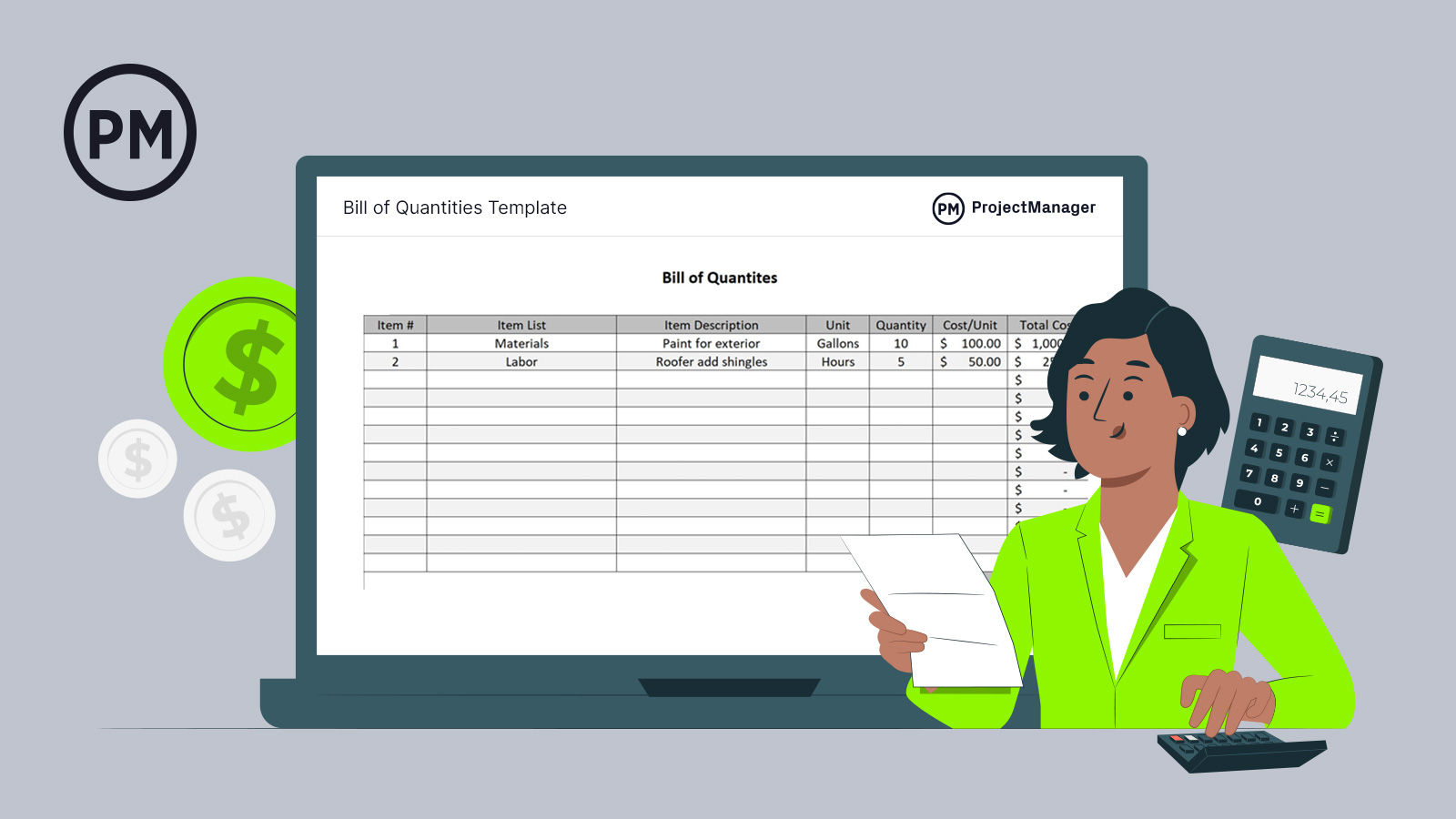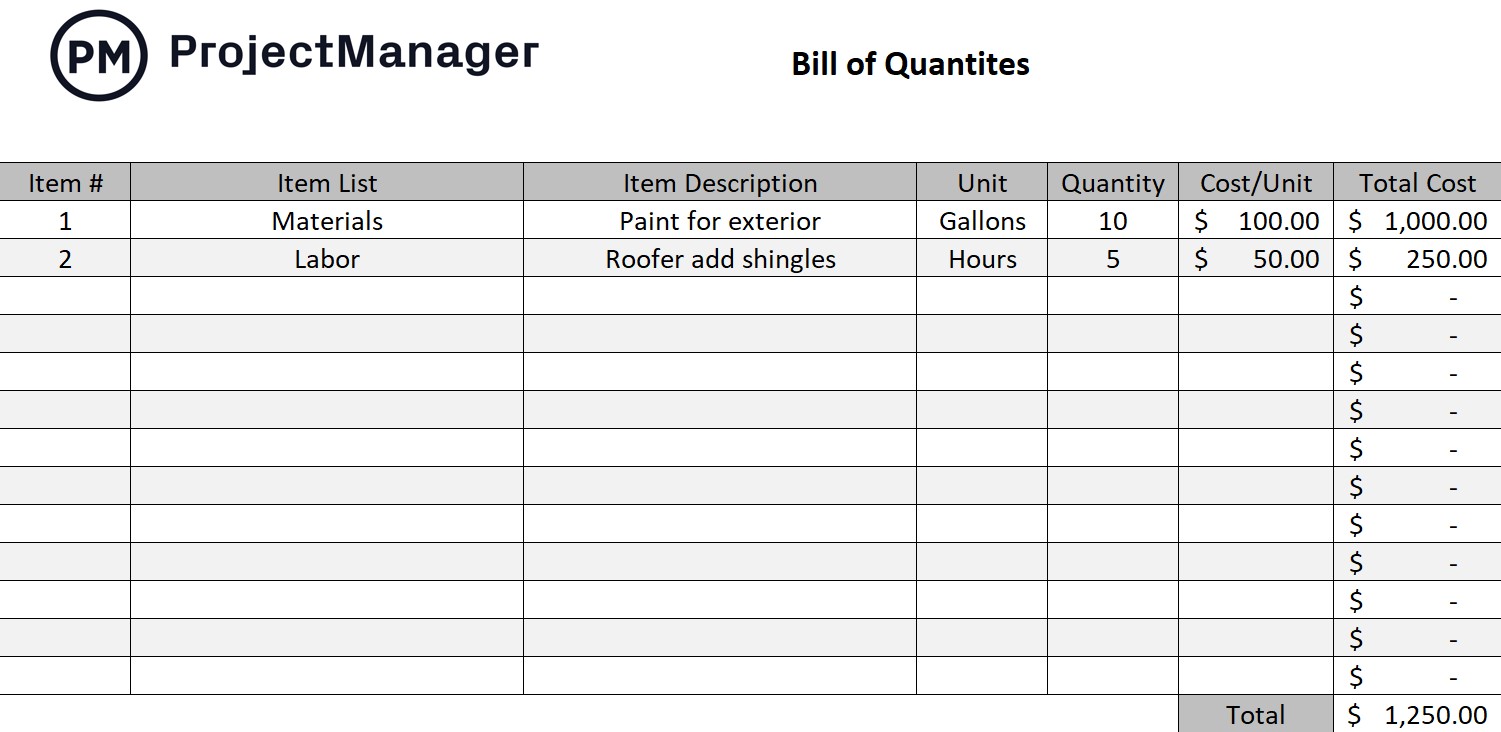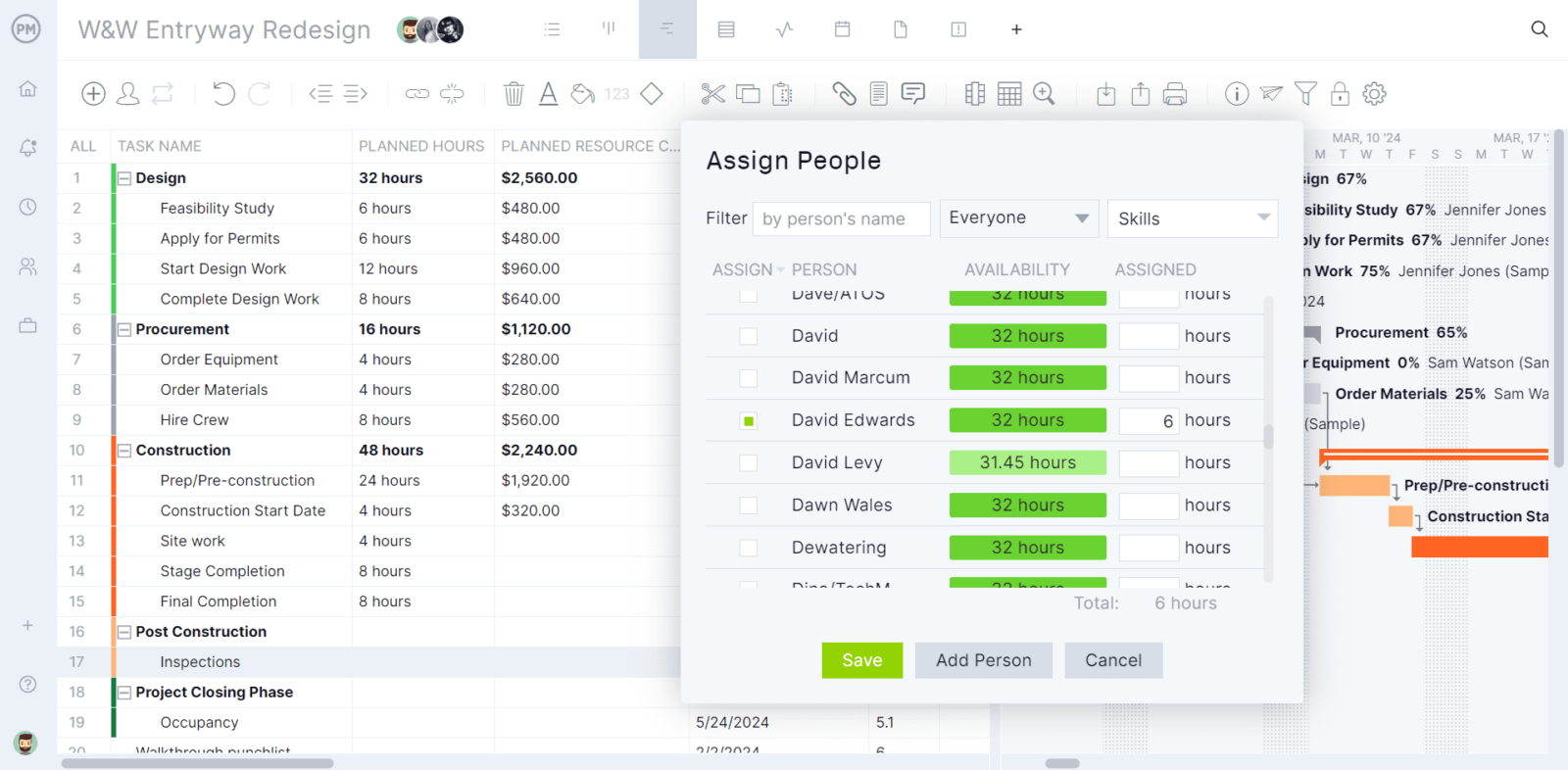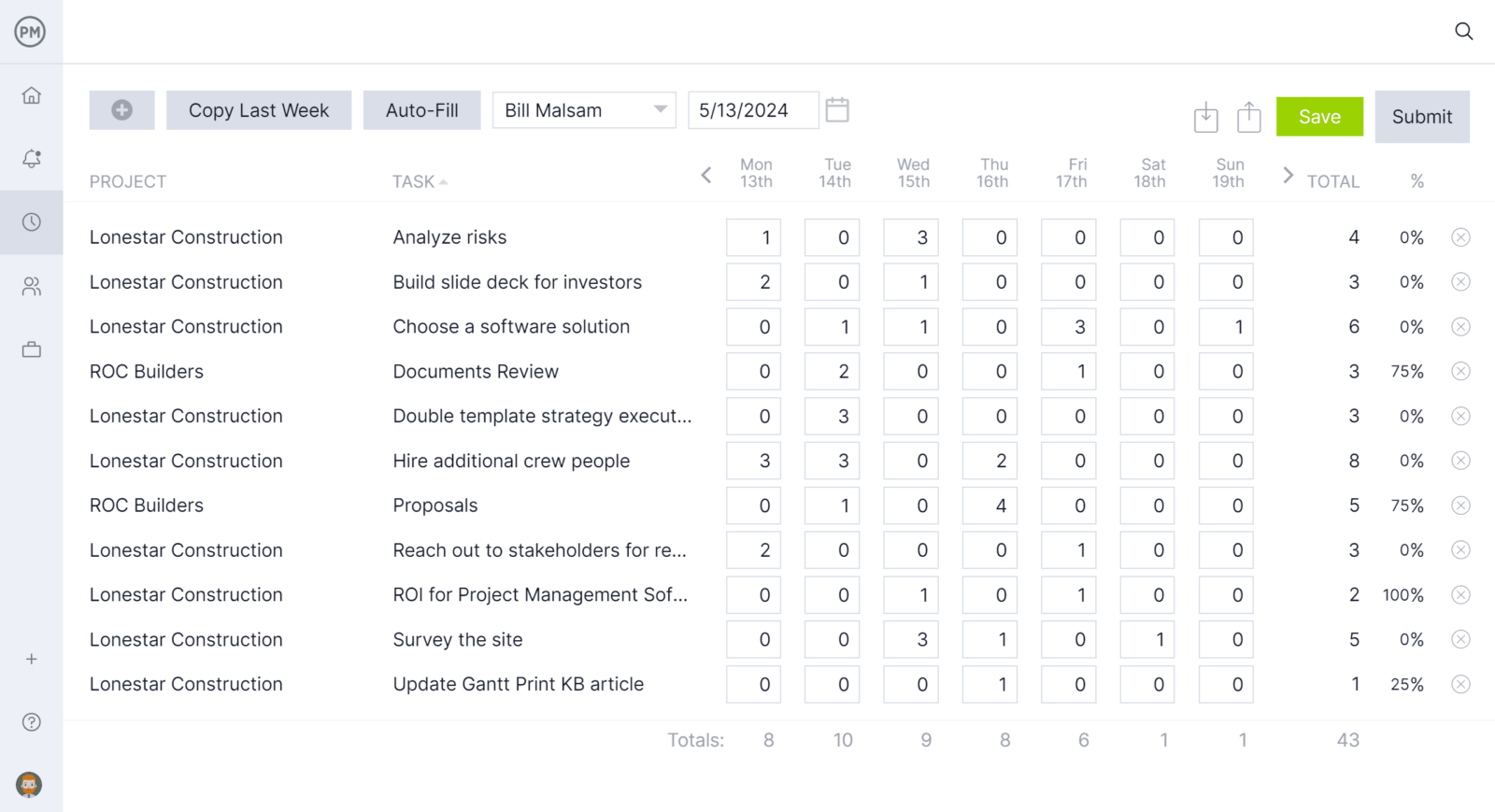A bill of quantities is an important document in construction project management. Making any building or structure involves many things, but few are as important as materials and labor. Without these two elements, there’s little use for a plan and schedule.
Some even say that all construction projects begin with a bill of quantities. We’ll explain what a bill of quantities is, why it’s so important to construction project management and detail what should go into one. Then we’ll throw in a free bill of quantities template that you can use in your next construction project.
What Is a Bill of Quantities (BoQ) in Construction?
A bill of quantities is essentially a list of all the materials and labor that will be required for your desired build. It’s often put together before a construction contractor has been hired and is a guiding document for those companies that are bidding for the work.
Once the construction project has been approved to move forward, an owner will usually employ the architect or engineer to draw up the bill of quantities. Since the document is a thorough listing of all the needed materials and labor, these two professionals will have the clearest picture of what those materials and laborers are.
The bill of quantities is then used as a means of forecasting costs, which helps the owner and the bidding contractors in that they both have a better picture of the price of completing the construction work. Therefore, owners know which bids are competitive and bidding contractors can better estimate their profit margins.

Get your free
Bill of Quantities Template
Use this free Bill of Quantities Template to manage your projects better.
Get the template
Types of Bill of Quantities (BoQ)
A bill of quantities is used in construction, but also in project management. As defined above, it’s a document that provides detailed measurements and descriptions of the work to be performed. There are, however, more than one type of bill of quantities. Below are a handful of the more commonly used ones.
Preliminary or Approximate Bill of Quantities
This bill of quantities is used for initial budgeting and feasibility studies at the beginning of a project, as the name suggests. It provides an early estimate of costs before a detailed design has to be completed.
Detailed Bill of Quantities
As one would expect considering the name of this bill of quantities, it includes comprehensive measurements and specifications for every item of work. That’s why it’s used for tendering and contracting purposes.
Elemental Bill of Quantities
This is used in construction to categorize work items into specific elements or components of a project. It organizes costs by breaking down the project into major elements. This helps with analyzing and comparing costs across different sections of the work.
Provisional Bill of Quantities
This bill of quantities includes items for which the quantities of costs are not yet fully defined. It serves as a placeholder for work that is anticipated but not precisely measured or specified at the time of tendering.
Trade Bill of Quantities
This specialized version of a bill of quantities focuses on specific trades or disciplines within a construction project. It breaks down the work according to different trades, such as electrical, plumbing, carpentry or masonry and provides detailed quantities and descriptions for each.
Materials and labor are some of the main resources that construction projects work with and are instrumental to delivering a workable project plan. ProjectManager is award-winning software that has robust Gantt charts to manage resources, costs and more when planning and scheduling construction work. Once you’ve added all your tasks, you can link all four types of task dependencies to avoid costly delays. There’s even a filter to find the critical path. Then set a baseline to track your planned effort against your actual effort in real time and stay on schedule. Get started with ProjectManager today for free.

Bill of Quantities vs. Bill of Materials
The bill of quantities and the bill of materials are both used in construction project management but serve different purposes. As we’ve learned, the bill of quantities is primarily used for cost estimation and tendering, while a bill of materials is a list of the raw materials and components that are required for a project.
The bill of quantities focuses on the scope of work and project costs. It helps with managing and controlling project budgets. The bill of materials, on the other hand, focuses on the materials needed for construction rather than labor or overhead costs. It’s an essential document for procurement processes and ensuring material availability.
Why Is a Bill of Quantities Important In Construction?
The bill of quantities might seem like a straightforward construction document, and in many ways, it is. This is where you first detail all the materials and labor you’ll need to execute your project. This process is critical in finding the best prices for the materials and labor you need before you’re committed to the execution of that construction project.
It’s also helpful in figuring out the scope of the project. Once you have all the materials and labor charted out on your bill of quantities, it’s only a small step forward to detail the tasks that will be required to meet the goals of the project.
As noted above, the bill of quantities is also helpful when a project owner is looking for construction contractors. It makes the bidding process more precise as the owner understands how much the project will cost. It also gives the bidding contractor a better idea of the range they can quote for a realistic project price while leveling the playing field as all contractors are bidding on the same work.
Finally, the owner of the project can use the bill of quantities as a cost control. The breakdown of the bill of quantities will inform the project schedule which allows the project owner to understand the amount of work that’ll be done in each billing cycle. They can then prepare the cash flow and measure the project’s progress.
What Should Be Included in a Bill of Quantities?
A bill of quantities can be used for many purposes, but its main goal is to act as a list of all the materials and labor that will be used throughout a construction project. This means it must capture the relevant details for these items to be useful. There are, of course, different bills of quantities, but the following is usually the common denominator among all of them.
Work Breakdown Structure
A work breakdown structure helps with creating a bill of quantities by providing a clear and organized framework for project tasks and deliverables.
Item Number
First, you’ll want to number your list. Each item, whether material or labor, should have a corresponding number to make it easier to find as the list grows long.
Item List
Now you’ll want to differentiate between the two types of items on your bill of quantities. Here’s where you’ll note if it’s a material or labor.
Item Description
Next is the item description, for example, “paint” would describe an item. But you’ll want to add some context, especially since there’s likely to be paint used for several different things in the construction project. Consider adding paint with a short description, such as for the exterior of the building.
Measurement Unit
Whether the item is material or labor, you need to define how it’s measured. For instance, the material would be by the gallon if it’s paint, while the painter would be measured by the hour because they’re a laborer.
Quantity
Another important piece of information that’s critical to a thorough bill of quantities is the quantity of each item. How many gallons of paint will you need to paint the exterior of the building, and how many hours will it take for the painters to do this job? The answer to these questions is detailed here.
Cost Per Unit
Also important is the price of the materials or the labor which is listed here. For example, a gallon of paint might cost $5 while the painters are contracted at $25 per hour.
Total Item Cost
Finally, you’ll want to address the total cost for each line item. Multiply the paint’s price per gallon by the amount of paint you need to do the job. The same is done for labor. At the bottom of your bill of quantities, you’ll add all these totals together to get a total for all the materials and labor that will be used in the construction project.
Free Bill of Quantities Template for Excel
If you want to see what a bill of quantities looks like, we have a free bill of quantities for Excel that you can download. It is but one of the dozens of free project management templates for Work and Excel that you can find on our site. There are free templates for every stage of a project, including many for construction project management.

We offer a variety of free construction project management templates for Excel you can use to manage all aspects of your project.
Bill of Quantities Example
To better illustrate what a bill of quantities is, let’s take a look at a simple construction project. You’re making a dog house for your backyard. The bill of quantities is going to collect everything you have to use to make the dog house.
Therefore, it’ll list wood, nails and paint, defining where these will be used and how much of each is necessary. You’ll also list all the labor involved, from cutting the wood to assembling the dog house frame and adding siding, nailing this together and painting the finished product.
You could do this job yourself, in which case you have all the materials and labor already detailed. Or you could contract the work and the bill of quantities will allow you to see which contractor is providing you a fair price for their services.

Who Is Responsible for Creating a Bill of Quantities?
The project owner is responsible for the bill of quantities. However, they’re rarely the ones who put together the bill of quantities. While they need one to get accurate bids from contractors and use it to provide to those contractors that are bidding on the project, they more often than not delegate the responsibility.
That’s perfectly reasonable as the construction project owner is not necessarily privy to all the details of the project. That’s why they’ll give the task to the architect and the engineer, two professionals who have a close relationship with the various materials and the labor necessary to build the construction project.
When Should You Use a Bill of Quantities?
The bill of quantities is used by the construction industry owner when calculating the total cost for a project. This allows the owner to understand the cost of the project and how it’ll be paid over the various phases of the project.
This is all done before the execution of the project, but after the project has been approved. The bill of quantities is then shared with the bidding construction contractors, who used the information therein to help them come up with their bids for the job.
While the bill of quantities is generally used before ground is broken on the construction project, it can be helpful in tracking progress after execution as well. By looking at your list of materials and labor and seeing what’s been done and what’s still to be done, you can get a general idea as to where you are in the project.
ProjectManager Helps With Construction Project Management
ProjectManager is award-winning construction project management software that helps you manage resources to keep your projects on track. After you’ve done all that work with the bill of quantities, you want to ensure your resources are working as you planned on the Gantt chart. We have resource management features to help plus multiple project views so the plan you created on the Gantt chart can be viewed by your crew on task lists, kanban boards and calendars allowing them to do their job with tools that focus on task management.
Keep Teams Productive With Resource Management Features
Once you’ve executed the project, you’ll need to monitor your resources to make sure they align with your construction project plan. First, you can onboard your crew and identify their availability, including PTO, vacation and global holidays. That makes it easier to assign them jobs. Then you’ll want to monitor their workload to make sure they’re working at capacity but not overextended, which will impact their productivity and morale. Toggle over to our color-coded workload chart and you get an overview of their task allocation and can reallocate as necessary to balance their workload and keep teams productive.

Streamline Payroll With Secure Timesheets
Another tool that helps you track their work is our secure timesheets. They streamline payroll, lock when submitted to management for review and can even auto-populate so no one has to take the time to manually input all that data. But they also provide a window into the percentage of work that’s been completed on the assigned tasks. Managers can look at the timesheets or generate a timesheet report to get further details on their progress.

Once you set a baseline on the Gantt chart, you can track your resources across the software. There are real-time dashboards that give you a high-level view of the project without having to waste time on configuration as you do with lightweight tools. There are also customizable reports that can give you more detail and are easy to share with stakeholders when they want updates.
ProjectManager is online project management software that empowers teams to plan, manage and track their work in real time. Risk management, task management and resource management tools help you stay on schedule, while our security features make sure all your proprietary work stays secure. Get started with ProjectManager today for free.

